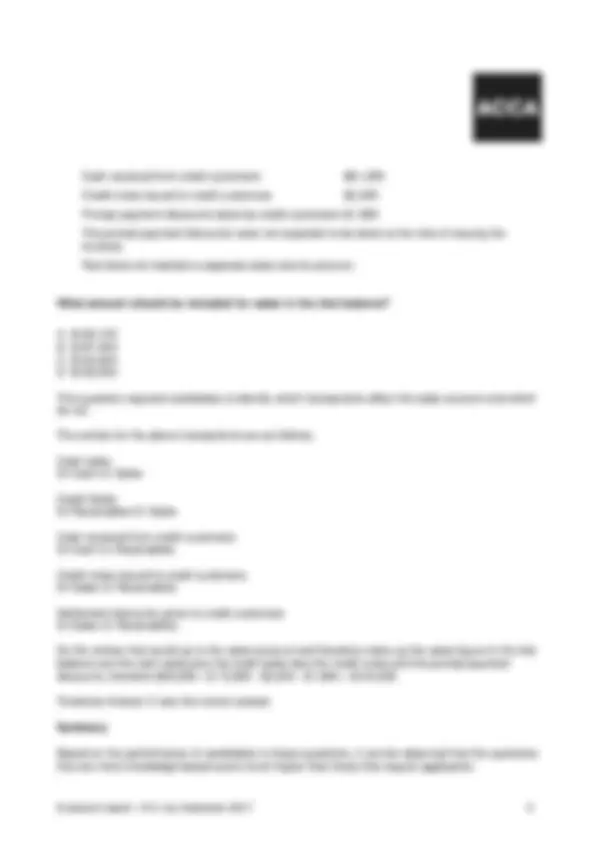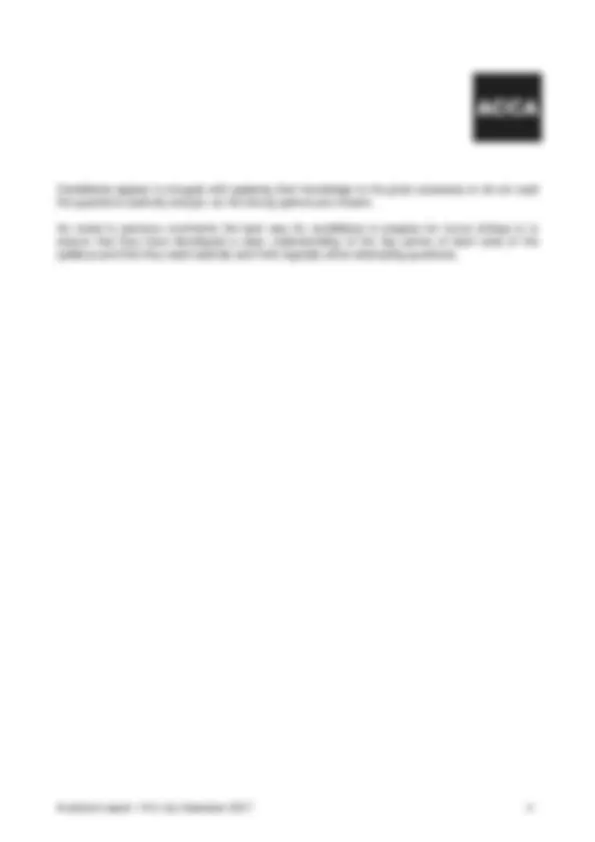




Study with the several resources on Docsity

Earn points by helping other students or get them with a premium plan


Prepare for your exams
Study with the several resources on Docsity

Earn points to download
Earn points by helping other students or get them with a premium plan
Community
Ask the community for help and clear up your study doubts
Discover the best universities in your country according to Docsity users
Free resources
Download our free guides on studying techniques, anxiety management strategies, and thesis advice from Docsity tutors
An examiner's report for the fa1 financial accounting exam held from july to december 2017. The report includes general comments, sample questions with answers, and explanations. The questions cover topics such as payables control account reconciliation, recording sales tax, and identifying transactions affecting the sales account.
Typology: Exercises
1 / 4

This page cannot be seen from the preview
Don't miss anything!



General Comments The intention of this report is that, when considered in conjunction with previous reports, candidates at future sittings will have a resource which maximises their chance of success. The most effective way to use these reports is to consider both the technical content of each question, and the approach to answering the question – noting that different question types will require slightly different approaches. Of the 50 multiple choice questions on the December paper, there were no questions not attempted by any candidates, as I have stressed this in previous reports, this was very pleasing to see. Sample questions for discussion Example 1 Anne’s payables control account shows a credit balance of $35,000. The total of the individual suppliers’ balances in the payables ledger is $40,000. Which of the following is the reason for the difference? A A purchase invoice of $5,000 has been omitted from the purchase day book B The total of the purchase day book has been overcast by $5, C A purchase return of $5,000 has been omitted from the control account D A sales invoice of $5,000 has been credited to an individual supplier’s account Reconciliation of the control account to the total of the list of the individual accounts is a topic that continues to test students due to the high level of application. This questions tests the difference between the payables control account – which is made up of the totals from the books of prime entry and the payables ledger which is made up of the total from the individual supplier accounts. With these questions it is important to identify which account is affected, is it the control account or the list of individual supplier accounts. Candidates need understand how the process works. A purchase invoice is entered into the purchase day book, from there it is recorded in the individual supplier account, then at the end of the day the total of the purchase day book is posted to the payables control account. In this question the control account is $5,000 lower than the total of the individual balances so if we look at options. Answer A – if an invoice was omitted from the purchase day book, it would not be recorded in either the individual’s account or the control account so both would be wrong by the same amount.
Answer B – if the purchase day book is overcast then the amount on the control account would be more that the total of the individual accounts, as it was lower this answer could be ruled out. Answer C – a purchase return has been omitted from the control account, again if this was the case it would make the balance on the control account more not less than the total of the individual accounts, so this could also be ruled out. Answer D – this was a sales invoice that had been incorrectly posted to an individual’s payable account instead of correctly going to a receivables account and this would therefore cause the individual payable account to be overstated and would result in $5,000 more than the control account. This was therefore the correct answer. Example 2 On 4 June Matthew received $3,000 cash from a credit customer and $360 from a cash sale. Matthew is registered for sales tax at 20%. What amount of sales tax should be recorded in the cash book on 4 June? A $ B $ C $ D $ This question tests the point at when a company records the sales tax on a transaction. If the transaction is a credit sale – the first time it is recorded in the books of prime entry is when the invoice is entered into the sales day book, at this point the sales tax will be recorded, not when the cash is received from the credit customer. If the transaction is a cash sale – the first time it is recorded in the books of prime entry is when the cash is received and entered into the cash book, at this point the sales tax will be recorded. So when Matthew receives the $3,000 from the credit customer the sales tax is not recorded in the cash book as it would have already been accounted for in the sales day book. When Matthew receives the $360 from the cash sale, the sales tax will need to be recorded in the cash book. The amount received will be inclusive of the sales tax so the amount of sales tax to record in the cash book will be 360 x 20/120 = $60. Therefore Answer B was the correct answer. Example 3 The following information relates to Ravi’s sales for the year: Cash sales $56, Credit sales $72,
Candidates appear to struggle with applying their knowledge to the given scenarios or do not read the questions carefully enough, so the wrong options are chosen. As noted in previous comments the best way for candidates to prepare for future sittings is to ensure that they have developed a clear understanding of the key points of each area of the syllabus and that they read carefully and think logically when attempting questions.